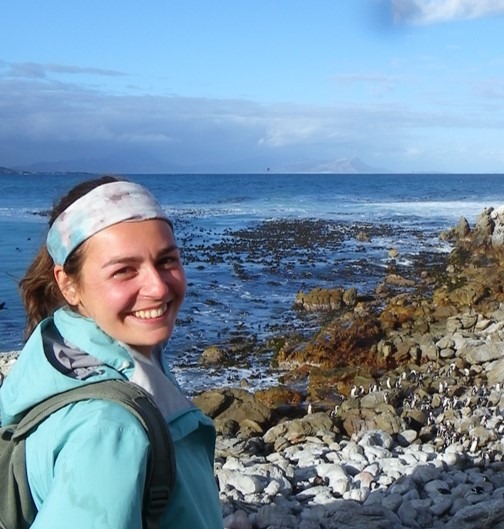
Lisa
Jacquin
Lisa Jacquin est enseignante-chercheuse en écologie évolutive à l’Université Paul Sabatier Toulouse 3, au sein du laboratoire Evolution & Diversité Biologique depuis 2014 et à l’Institut Universitaire de France depuis 2021.
Avec ses collègues, Lisa étudie depuis plusieurs années l’évolution des réponses au stress et de la coloration chez les animaux, en particulier chez les oiseaux et les poissons, dans les écosystèmes naturels et modelés par les activités humaines.
Lisa Jacquin est co-autrice de nombreuses publications, notamment sur le thème de la coloration animale dans des revues variées telles que Freshwater Biology, Biological Journal of the Linnean Society ou encore Behavioral Ecology.
Bibliographie
Côte Jessica, O Morisseau, C Pilissi, C Veyssière, A Perrault, C Jezequel, G Loot, S Blanchet, S Jean, L Jacquin 2021. Urbanization and eutrophication as drivers of morphological and physiological divergence in fish. Freshwater Biology, 66: 669-682.
Côte Jessica, Pilissi C, Morisseau O, Veyssière C, Perrault A, Jean S, Blanchet S, Jacquin L. 2019. Water turbidity affects melanin-based coloration in gudgeon: a reciprocal transplant experiment. Biological Journal of the Linnean Society, 4128: 451–459.
Côte Jessica, Boniface A, Blanchet S, Hendry AP, Gasparini J, Jacquin L. 2018. Melanin-based coloration and host-parasite interactions under global change. Proceedings of the Royal Society B, 285: 20180285.
Jacquin L, Gauthey Z, Roussille V, LeHénaff M, Tentelier C, Labonne J. 2017. Melanin in a changing world: brown trout coloration reflects alternative reproductive strategies in variable environments. Behavioral Ecology, 28: 1423–1430
Ducatez S, Giraudeau M, Thébaud C, Jacquin L. 2017. Colour polymorphism is associated with lower extinction risk in birds. Global Change Biology, 23:330-339.
Corbel H., Legros A., Haussy C., Jacquin L., Gasparini J., Karimi B., Frantz A. 2016. Stress response varies with plumage color and local habitat in feral pigeons. Journal of Ornithology, 157: 825.
Chatelain M., Gasparini J., Jacquin L., Frantz A. 2014. The adaptive function of melanin-based plumage coloration to trace metals. Biology Letters, 10(3).
Jacquin L., Mori Q., Médoc V. 2013. Does the carotenoid-based colouration of Polymorphus minutus parasite facilitate its trophic transmission to definitive hosts? Parasitology 140:1310-1315.
Récapet C., Dauphin L., Jacquin L., Gasparini J., Prévot-Julliard AC.2013. Darker eumelanic juvenile of feral pigeons display a higher survival than paler ones in an urban pigeon house. Journal of Avian Biology, 44:001-008.
Jacquin L., Récapet C., Prévot-Julliard AC., Leboucher G., Lenouvel P., Erin N., Frantz A., Corbel H., Gasparini J. 2013. A potential role for parasites in the maintenance of bird color polymorphism in cities. Oecologia 173:1089-1099.
Derelle D., Kondrashov F., Arkhipov V., Corbel H., Frantz A., Gasparini J., Jacquin L., Jacob G., Thibault S., Baudry E. 2013. Color differences among feral pigeons are not attributable to sequence variation in the coding region of the MC1R gene. BMC Research Notes 6:310
Jacquin L., Haussy C., Bertin C., Laroucau K., Gasparini J. 2013. Darker female pigeons transmit more specific antibodies to their eggs than do paler ones. Biological Journal of the Linnean Society, 108: 647-657
Jacquin L., Récapet C., Bouche P., Leboucher G., Gasparini J. 2012. Melanin-based coloration reflects alternative strategies to cope with food limitation in feral pigeons. Behavioral Ecology, 23: 907-915.
Jacquin Lisa. Coloration mélanique et stratégies d’histoire de vie chez le pigeon biset urbain, 2011. Thèse de l’Université Pierre et Marie Curie, Sorbonne Université.
Jacquin L., Lenouvel P., Haussy C., Ducatez S., Gasparini J. 2011. Melanin-based coloration is related to parasite load and cellular immune response in feral pigeons. Journal of Avian Biology, 42:11-15
Pour une bibliographie complète, cliquez ici.
